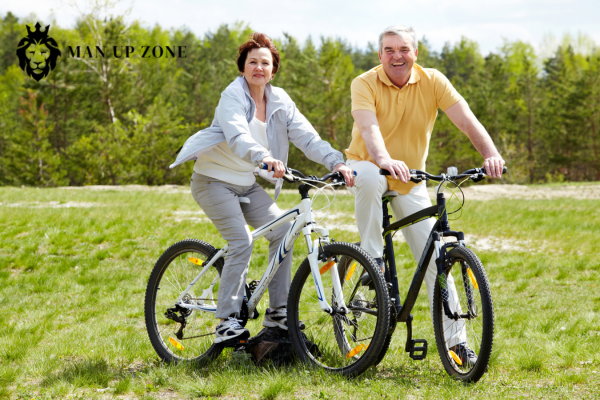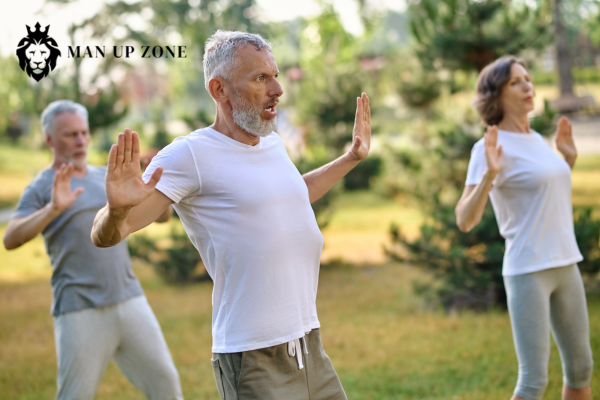
Top 10 Anti-Aging Exercises for Men: Stay Youthful and Energized
As men age, staying active becomes crucial for maintaining vitality and youthfulness.
Regular exercise can significantly slow down the aging process, keeping you feeling energetic and looking your best.
By incorporating specific anti-aging exercises into your routine, you can improve muscle tone, boost metabolism, and enhance overall well-being.
Wondering which exercises are most effective for combating the signs of aging? You're in luck!
We've compiled a list of the top 10 anti-aging exercises tailored specifically for men. These workouts target key areas that often show the effects of aging, helping you maintain a youthful appearance and vigor.
Ready to turn back the clock? Let's explore these powerful exercises that can help you look and feel younger.
Whether you're a fitness enthusiast or just starting your journey, there's something for everyone in this comprehensive guide.
Benefits of Regular Exercise for Aging Men
Regular exercise offers numerous advantages for men as they age.
It helps maintain physical function, promotes overall health, and enhances quality of life.
Improved Muscle Mass and Strength
As you get older, muscle mass naturally declines.
Regular strength training can help you maintain and even build muscle. This leads to improved strength, making daily activities easier.
Resistance exercises like weightlifting or bodyweight exercises are particularly effective.
Aim for 2-3 strength training sessions per week, targeting all major muscle groups.
Increased muscle mass also boosts metabolism, aiding in weight management. This is crucial as metabolism tends to slow with age.
Enhanced Flexibility and Balance
Flexibility exercises help maintain joint mobility and reduce the risk of injuries.
Improved balance decreases the likelihood of falls, a common concern for older adults.
Try incorporating stretching routines into your daily schedule.
Yoga and tai chi are excellent options that combine flexibility and balance training.
Regular practice can improve your posture and reduce muscle tension. This leads to better overall body awareness and coordination.
Cardiovascular Health
Aerobic exercises are vital for heart health.
They strengthen your heart, improve circulation, and help manage blood pressure.
Activities like brisk walking, swimming, or cycling for 30 minutes a day, 5 days a week, can significantly benefit your cardiovascular system.
Regular cardio exercises also boost lung capacity and endurance. This means you'll have more energy for daily activities and feel less fatigued.
Cardiovascular exercise can help manage cholesterol levels and reduce the risk of heart disease, a leading health concern for aging men.
Resistance Training: Building Muscle and Bone Density
Resistance training is a crucial component of anti-aging exercise for men.
It helps maintain muscle mass, increases bone density, and boosts metabolism.
Weightlifting Fundamentals
Start with compound exercises that target multiple muscle groups.
Focus on proper form and technique to maximize benefits and prevent injuries. Begin with squats, deadlifts, bench presses, and rows.
Aim for 2-3 sets of 8-12 repetitions for each exercise.
Gradually increase the weight as you get stronger. Rest for 60-90 seconds between sets.
Include exercises for all major muscle groups:
Legs: Squats, lunges, leg press
Chest: Bench press, push-ups, chest flyes
Back: Rows, pull-ups, lat pulldowns
Shoulders: Overhead press, lateral raises
Arms: Bicep curls, tricep extensions
Bodyweight Exercises
No equipment? No problem! Bodyweight exercises can be just as effective for building strength and muscle.
Try these exercises:
Push-ups
Pull-ups
Squats
Lunges
Planks
Dips
Start with 3 sets of 10-15 repetitions for each exercise.
Increase the number of reps or add variations as you progress.
Incorporate bodyweight exercises into a circuit training routine for added cardiovascular benefits.
Perform each exercise for 30 seconds, then move to the next with minimal rest between.
Cardiovascular Exercises for a Healthy Heart
Regular cardiovascular exercise strengthens your heart and improves circulation. These activities can help slow the aging process and boost your overall health.
Brisk Walking and Jogging
Start with brisk walking to get your heart pumping.
Aim for 30 minutes a day, five days a week. As you build stamina, gradually increase your pace.
Try intervals of jogging and walking. Jog for 1-2 minutes, then walk for 3-4 minutes. Repeat this cycle for your workout duration.
Invest in supportive shoes to protect your joints.
Choose routes with varied terrain to challenge different muscle groups.
Track your progress using a fitness app or smartwatch. Set achievable goals and celebrate your improvements.
Cycling for Endurance

Hop on a bike for a low-impact cardio workout.
Start with short rides around your neighborhood or on a stationary bike at the gym.
Gradually increase your distance and intensity.
Try hill climbs to boost your heart rate and build leg strength.
Join a cycling group for motivation and social interaction. Many communities offer group rides for various skill levels.
Consider investing in a good-quality bike that fits your body. Proper gear can make your rides more comfortable and enjoyable.
Mix up your routes to keep things interesting. Explore new trails or scenic roads in your area.
Cycling can be great fun and addictive, specially when you cycle with a friend or partner.
Flexibility and Balance Routines
Incorporating flexibility and balance exercises into your routine can significantly improve your agility and reduce the risk of injuries as you age. These practices help maintain joint mobility and enhance overall stability.
Yoga and Pilates
Yoga offers a range of benefits for men looking to age gracefully.
Regular practice can increase flexibility, strengthen core muscles, and improve balance.
Try starting with basic poses like Downward Dog, Warrior I, and Tree Pose.
As you progress, challenge yourself with more advanced postures.
Aim for 2-3 yoga sessions per week, each lasting 30-45 minutes.
Pilates focuses on core strength and spinal alignment.
It's excellent for improving posture and preventing back pain.
Key exercises include the Hundred, Roll-Up, and Plank. Consider taking a beginner's class to learn proper form.
Combine Pilates with your strength training routine for optimal results.
Even 15-20 minutes of Pilates exercises 3 times a week can make a noticeable difference.
Tai Chi Practices

Tai Chi is a gentle, low-impact exercise that's perfect for men of all ages.
It combines slow, fluid movements with deep breathing and meditation.
Regular practice can improve balance, flexibility, and mental clarity.
Start with basic Tai Chi forms like "Grasp the Bird's Tail" or "Wave Hands Like Clouds."
Focus on maintaining proper posture and smooth transitions between movements.
Aim for 15-20 minutes of Tai Chi daily, preferably in the morning.
You can find instructional videos online or join a local class to learn from an experienced instructor.
Tai Chi's stress-reducing effects can also contribute to better sleep and lower blood pressure.
As you become more proficient, you'll notice improved coordination and a greater sense of body awareness.
Core Strengthening for Posture and Stability
Strong core muscles are essential for maintaining good posture and stability as you age. These exercises target your abdominal and back muscles to improve your overall balance and reduce the risk of falls.
Plank: Start in a push-up position, holding your body straight for 30 seconds. Gradually increase the duration as you build strength.
Bird Dog: On your hands and knees, extend your right arm forward and left leg back. Hold for 5 seconds, then switch sides. Repeat 10 times per side.
Bridges: Lie on your back with knees bent and feet flat. Lift your hips, squeezing your glutes. Hold for 5 seconds, then lower. Do 3 sets of 10 repetitions.
Russian Twists: Sit with knees bent and feet off the ground. Lean back slightly and rotate your torso from side to side. Aim for 20 twists per set.
Superman: Lie face down with arms and legs extended. Lift your limbs off the ground simultaneously. Hold for 5 seconds, then lower. Repeat 10 times.
These exercises can be done at home with minimal equipment.
Start with 2-3 sets of each exercise, 2-3 times per week.
Remember to breathe steadily and maintain proper form throughout each movement.
Recovery and Rest: Essential Components of Exercise
Rest days are crucial for your anti-aging exercise routine. They allow your body to repair and strengthen itself between workouts.
Aim for 1-2 rest days per week to prevent burnout and injuries.
Quality sleep is equally important. During deep sleep, your body releases growth hormone, which aids in muscle repair and recovery.
Try to get 7-9 hours of sleep each night for optimal results.
Active recovery can be beneficial on rest days. Light activities like walking, swimming, or yoga can improve blood flow and reduce muscle soreness without overtaxing your body.
Proper nutrition supports recovery. Focus on protein-rich foods to help rebuild muscle tissue.
Include plenty of fruits and vegetables for their antioxidant properties.
Hydration is key. Drink water throughout the day, especially before, during, and after exercise.
Proper hydration helps flush out toxins and keeps your muscles functioning optimally.
Consider these recovery techniques:
Foam rolling
Massage
Stretching
Ice baths
Compression garments
Listen to your body. If you feel excessively fatigued or sore, take an extra rest day. Pushing too hard can lead to overtraining and setbacks in your anti-aging fitness journey.